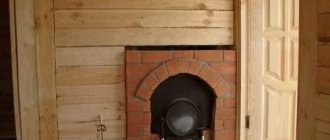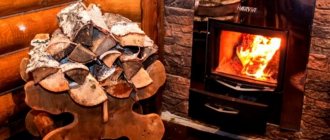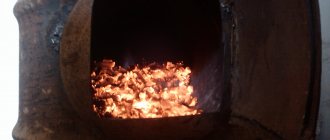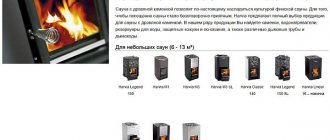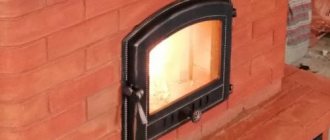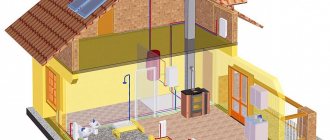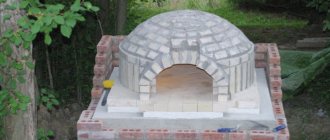Criterias of choice
The main indicators that must be taken into account when choosing a stove are the following:
- mechanism of action;
- manufacturing materials;
- fuel.
Baths can be heated using permanent or temporary (periodic) stoves. The first ones need to be kept burning the entire time the steam room is in use. For the second, preliminary high-quality heating is enough.
The range of materials from which a heater can be made now includes a large number of traditional and new technological elements.
The best stoves are made of steel and brick.
Brick structures
The leaders in demand are heaters made of periodic bricks. Continuous combustion heaters are also used to provide heating for saunas. but much less often.
Brick kilns of intermittent operation have both an advantage - they maintain a high temperature in the room for a long time, and a disadvantage - they need to be warmed up for at least 5 hours. In winter this takes even longer. Therefore, if bathing procedures are planned for the evening, then you need to start heating in the afternoon. After this, you can steam and not be distracted by other things, the heating will work without outside interference.
There is another disadvantage of such models - high cost. It is quite difficult to make such a heater yourself. To get a truly functional stove, you need an experienced stove maker. And his work is highly paid. The high cost of the heating structure can also be explained by the fact that it is necessary to lay a powerful foundation that will support a heavy brick heater.
Metal heat sources
Metal furnaces are characterized by the principle of constant operation. A stove with thin steel walls does not retain heat for long, which can be attributed to its disadvantages. And the advantage of a metal sauna stove is that it will take much less time to warm up the room.
In winter, this will take no more than 2 hours. It is better to organize heating using a steel heater in a small bathhouse. You can install the stove yourself.
Heating by stove-stove
For small baths, a traditional heater remains a viable heating option. In this case, it is enough to purchase or manufacture a heating unit of the required power.
Calculation of equipment power is determined by the formula: 1 kW of power per 1 sq. m of premises. To ensure a comfortable stay for visitors in the steam room, a thermal power reserve of 35 to 55% is additionally taken into account.
The popularity of the heating heater is explained by the following advantages:
- ease of installation and maintenance;
- accessibility of operation;
- using available fuel.
When giving preference to a sauna stove, do not forget about some of the disadvantages of the device:
- impressive dimensions and weight;
- inability to automate the process of heating rooms;
- high fire hazard;
- formation of fuel combustion products.
Modern heaters operate on wood, electricity, liquid and gaseous fuel. The choice of the appropriate option depends on the financial capabilities and technical capabilities of the equipment.
Warm floor system
This option for heating a bathhouse is one of the modern methods, which has been used frequently in recent years. It is quite difficult to install special equipment without the appropriate experience.
It is much easier to install an electric floor system and you can do this work yourself:
- First of all, a waterproofing material is laid, on which a layer of mortar is placed.
- Next comes the installation of thermal insulation.
- An electrical cable is mounted on top of the thermal protection layer and the screed is refilled.
The technology for creating a floor with water heating is similar, but in this case they do not use a cable, but rather lay pipes to circulate the hot coolant.
Rules for organizing heating in a bathhouse
Wood heating sauna
The simplest option is a sauna with heating from home. This scheme involves connecting the steam room, dressing room and other premises to the autonomous heat supply of the cottage. But this can only be realized if the bathhouse structure is closely adjacent to the house or is located at a distance of no more than 3-4 m from it.
The most common option for the location of a building on a site is remote from a residential building. How to make water heating in a bathhouse and at the same time optimize the costs of its organization? Options for using standard schemes are possible, but at the same time the specifics of using the bathhouse should be taken into account:
- The source of thermal energy (boiler) must ensure heating of the air in the steam room to a level of +90°C +100°C. For this purpose, special sauna stoves with a container for stones are used;
- For rooms larger than 60 m², it is recommended to install pipe heating. Together with it, you can make a hot water system to increase comfort. If there is a second floor, heating of the attic of the bathhouse must be provided;
- Ensuring the removal of carbon monoxide along with a well-thought-out ventilation system;
- Fire safety. Since wood is used in the vast majority of cases for finishing rooms, its contact with heating elements - pipes, radiators - should be prevented.
Gas heating baths
Another important point is the choice of energy carrier. Gas heating in a bathhouse is advisable only when installing a specialized boiler. Installing homemade structures can lead to emergency and dangerous situations.
In addition to gas, you can use other, no less effective sources of thermal energy:
- Firewood. A traditional type of fuel with which heating a bathhouse in winter turns into a kind of ritual. A significant drawback is the constant monitoring of the fuel level in the firebox, as well as the impossibility of quickly adjusting the water heating level;
- Diesel fuel or used oil. The most unacceptable energy source for a bathhouse. The problem is the unpleasant smell and the difficulty in organizing fuel storage.
How to make gas heating for a bathhouse yourself? To do this, you need to choose the right equipment and components for heat supply - pipes, radiators, as well as containers for indirect heating of hot water.
When heating a bathhouse from the heating system of the house, part of the pipeline located on the street must be insulated. To solve this problem, you can use special heat insulators or an electric heating wire.
Fire safety requirements
When installing any sauna stove, it is necessary to strictly comply with fire safety requirements, since the walls of the device heat up to fairly high temperatures during its operation. In order to ensure maximum safety and not have problems with regulatory organizations, it is recommended to install the stove in accordance with the provisions prescribed in SNiP 41-01-2003 (Chapter 6.6).
- The first thing that needs to be done is to equip a reliable foundation for the main structure of the stove, which will be adjacent to the wall dividing the room. The foundation should be covered with heat-resistant material and then with metal sheet. Asbestos sheets were previously used as heat-resistant insulation. Today on sale you can find panels of pressed mineral wool, which is less dangerous from an environmental point of view, sheets of foam glass or EZHKAKH (heat-resistant structural mica plastic).
- It is also necessary to provide a metal flooring in front of the combustion door, which will prevent the wooden floor from catching fire and simplify debris removal. The size of the pre-furnace sheet must be at least 400×800 mm.
- If the partition between the steam room and the dressing room is wooden, then the opening through which the fuel channel will pass must be separated from the wood by brick or stone masonry. The distance between the stove and wooden walls should be 400÷450 mm.
In the version shown, the owner chose to fill the opening with bricks
- Provided that an opening is installed along the end part of the wall through which the combustion channel will pass, a gasket made of heat-insulating material (mineral basalt wool or cement-fiber sheet) with a thickness of 40÷50 mm, the distance between the part of the wall built from combustible material and the outer wall oven can be reduced to 250 mm. If thicker thermal insulation material is installed, the safe distance can be 125 mm.
- The distance between the ceiling of the bathhouse and the surface of the stove should not be less than 1200 mm.
- The distance from the edge of the combustion door to the nearest door must be at least 1250 mm.
- If you purchased a non-factory-made stove, or the device is independently made from sheet metal, then it is best to cover it with brick. Thus, it is possible to protect the structure of the bathhouse from fire, and people taking water procedures from burns. Factory products, as a rule, are made with double walls, between which thermal insulation material is laid or convection channels pass through.
Prices for foam glass
foam glass
We invite you to familiarize yourself with the 4x4 frame bathhouse with your own hands
Heating system
In most cases, continuous burning stoves are installed in bathhouses. which do an excellent job as the main source of heat in the room. At the same time, it is worth immediately making a reservation that for arranging the stove it is advisable to use only cleaned stones, the diameter of which reaches 10 centimeters. To achieve the optimal temperature in the room, it takes at least two hours to heat such a stove, during which you will have to periodically add firewood.
The bathhouse is a wooden building with a high level of humidity in the premises. As you know, wood that is regularly exposed to water can become unusable in a very short time. Because of this, unpleasant odors may appear in the bathhouse, and the building itself will require repairs in the future.
To avoid this, issues related to its quality heating should be resolved in advance. At the same time, it is advisable not to limit yourself to just one stove, but to supplement it with various heating systems, which, moreover, will significantly reduce the time it takes to warm up the premises before taking water procedures.
For safety reasons, in a wet room such as a bathhouse, it is allowed to use one or two heating radiators, which must be connected to the heating system of a residential building. In addition, there are several other options for heating a bath, the choice of which depends only on your requirements and wishes.
Heating radiators in the bathhouse
Drying the bath
There are two components to quickly drying wet rooms: heating and ventilation. They should not be considered separately, because together they work most effectively. You just need to combine them in a specific case.
How to dry: ventilation methods
The ventilation system is laid at the stage of construction of the bathhouse (see here about the diagrams and design of the bathhouse ventilation). Therefore, if something is forgotten, it may be too late to redo everything.
For example, vents are usually made in the foundation - these are through holes lined with sewer (most often) pipes that lead to the underground space. They have plugs on the outside that allow you to open and close them at the right time.
For more details about the scheme, see
Such vents are opened only after procedures. And they serve for better ventilation and drying of the bath.
Also, another through hole is usually made in the wall of the steam room under the shelves, leading to the street. On the inside it has an adjustable plug. This hole is also used to speed up the drying of the steam room.
You can dry the bathhouse in winter with the help of ventilation by opening the windows and doors wide - after all, the air inside is much more saturated with water vapor. But you shouldn’t think that all the moisture will leave the bathhouse only thanks to open doors and windows.
In addition to ways to create a draft simply by opening holes, there is also a method where ventilation actively cooperates with heating and works when the stove is on - this is bastu, which you can read about.
Well, don’t forget that even if natural ventilation is not installed correctly or its power is not enough to ventilate the bathhouse, you can always install fans in the air ducts. Forced ventilation, although noisy, is still effective.
BY THE WAY! Heat guns can help here too.
For those who believe that heating alone is enough, and ventilation becomes optional, we recommend watching the video by Konstantin Bely:
After washing: methods of heating
Heating is just as necessary for drying as ventilation. You understand the mechanism: by heating water molecules, you make them more mobile, transform the water into a gaseous state (steam), and it is easily carried away by the breeze. What will the breeze do if the water is cold? Nothing. And if there is no breeze, the steam will cool over time and calmly settle as condensation.
So, the easiest way to dry a bathhouse after washing in winter is to put one or two logs in the firebox and let them burn out. All ventilation openings must be open.
This is for an iron stove. A brick stove is a heat-storage stove, so its heat is enough to dry the bathhouse after the procedures (together with open ventilation).
***
Well, as you can see, you have to invest some money and make an effort in order to use a large bathhouse in the winter. The smaller it is, the easier it is to warm it up even in cold weather. The power of the sauna stove is calculated for the steam room; it is difficult to fit other things into its responsibilities, because there is summer when all this is not needed. So it is better to use autonomous heaters.
Installation of a sauna stove with a remote firebox
Do you need a foundation for a metal stove model? This question arises for many owners who decide to build a bathhouse. Therefore, it should immediately be noted that if the weight of the heating device does not exceed 400 kg (naturally, taking into account the stone backing), and the floors are planned to be made of boards at least 40 mm thick, then it is quite possible to do without arranging a foundation. Stoves made of stainless steel have this weight, while cast iron and brick models are heavier.
If you purchase a steel model of a sauna stove and plan to install it directly on wooden floors, then the installation site must be carefully prepared.
Ceramic tiles are laid on the floors, or first a sheet of asbestos or mineral wool is laid, which is covered with a steel sheet.
The stove must be installed on a non-combustible base, the walls must be covered with heat-resistant material. This, for example, could be a metal screen made of stainless steel.
However, do not forget that a bathhouse is a room with high humidity and water can get under the flooring installed under the stove, which is extremely undesirable. Therefore, the slope of the floor in the steam room must be made from the heating device, that is, it must be in the highest place in the room. In addition, the laid and secured flooring for installing the stove must be waterproofed around the entire perimeter. Today, a large number of sealants are available in construction stores for this purpose.
If you are installing a homemade steel stove, which is planned to be lined with brick, or a cast-iron model is selected, then it is better to equip a concrete foundation for it.
The solid concrete foundation for the furnace should not be in contact with the foundation of the main building. The dimensions of the foundation in length and width must exceed the dimensions of the heating device by 150÷200 mm on each side.
If the wooden floor in the bathhouse is strong and it is planned to build a brick podium on top of it for the stove, then before starting its construction, it is necessary to take measurements. If it turns out that the distance between the surface of the stove and the ceiling is less than the required parameter of 1200 mm, then it is recommended to abandon this option.
Work on the arrangement of a concrete shallow foundation includes several stages. And they are best carried out simultaneously with the construction of the bathhouse. But sometimes circumstances force these activities to be carried out in an already erected building.
| Illustration | Brief description of the operations performed |
| If the foundation is being built in an already built bathhouse, then the first step is to mark the installation location of the stove on the floor and the hole in the wall through which the fuel channel will pass. All markings are carried out according to the dimensions taken from the stove, taking into account allowances for installing thermal insulation. Next, the required opening is cut out in the wall along the marking lines. After this, part of the wooden floor is dismantled. Then a foundation pit is dug in the underground soil. | |
| Diagram of the arrangement of materials when arranging the foundation for a metal stove in a bathhouse. The linear parameters of the foundation can be changed in accordance with the size of the selected heating device. The depth of the foundation pit for installing a metal furnace should be 500 mm. After the pit is ready, the soil at its bottom must be compacted well. Then, sand is poured onto the bottom, which also needs to be compacted - its compaction thickness should be 100 mm. The sand layer will become a good waterproofing agent for the foundation from ground moisture. Next, crushed stone is laid on top of the sand - its thickness after compaction should be 150÷200 mm. It is recommended to lay a waterproofing material on top of the crushed stone, which should also cover the walls of the pit. Dense polyethylene or roofing felt can be used as waterproofing. | |
| A reinforcement cage is mounted on top of the waterproofing material or crushed stone. For this design, a reinforcing rod with a cross-section of 7 ÷ 8 mm is suitable, which is connected to each other by a lattice using knitting steel wire. Welded reinforcing mesh, which can be purchased ready-made in the store, is also quite suitable. | |
| The concrete screed is poured flush with the surface of the underground soil or raised to the level of the bathhouse floor. If the latter option is chosen, then temporary wooden formwork is installed from the ground to the entire height of the concrete slab. A concrete solution of at least M200 grade is poured into the prepared reinforced pit. After pouring and leveling the surface of the foundation, it is left until it completely dries and gains strength - this period is at least 28-30 days. | |
| The next step is to lay two layers of waterproofing material on the concrete surface - in this case, only roofing felt is used. A brick podium is laid on top of the roofing felt, consisting of one or two rows of bricks. | |
| The result should be approximately the same design as shown in the illustration. Next, you can move on to insulating the ends of the wooden walls, that is, protecting them from the effects of high temperatures to which the furnace body can heat up during operation. |
The installation of the stove can be done in different ways, depending on when it is installed. If the foundation is installed in a finished bathhouse structure, then an opening is cut in the wall according to the parameters mentioned above.
Asbestos prices
asbestos
Of course, it is more convenient to install the stove first, and then start building the partition. But this happens very rarely.
In another option for performing the work, which is considered more correct, the partition between two rooms is erected after erecting the foundation, installing the stove in a permanent place and lining it with bricks. However, such installation is possible only at the stages of building a bathhouse, or if a major reconstruction of premises with a large area is being carried out.
We suggest you read: Is it possible for sick people to take a steam bath?
If a factory-made heating device is installed, then it is worth carefully studying the passport attached to the product, in which the manufacturer indicates the recommended parameters for the distance of flammable surfaces from the stove. As a rule, for a unit with maximum power, the distance between the wooden wall and the stove is 250 mm if the stove is equipped with thermal insulation of the body, and 400 mm if it is not.
Lining the gap between the combustion channel and the walls of the opening with bricks
The opening parameters do not depend on the length of the outlet channel, but the wall must be insulated from the metal of the furnace with thermal insulation material over its entire thickness, and then with a steel sheet secured between the brickwork and the insulation layer.
Thermal insulation of the opening and surrounding walls with mineral wool slabs.
They can then be covered with steel sheet or (on the dressing room side) heat-resistant plasterboard. There must be a gap of at least 50 mm between the main structure of the stove and the wooden wall. If the insulation of the opening is limited to a layer of asbestos or mineral wool, then the surface of the partition facing the furnace must be lined with a heat-resistant material - this can be a sheet of asbestos, special plasterboard, pressed mineral wool or other high-temperature resistant materials.
The fuel channel passing through the opening cut into the wooden wall must be lined with brickwork. It must be taken into account that the brick must be separated from the metal of the furnace by a thermal gap of at least 20÷25 mm. This distance must be maintained in order to provide the necessary “degree of freedom” for the expansion of the metal when it is heated. The gap must be filled with heat-resistant elastic material - asbestos cord or stone wool.
Thermal insulation material separating a wooden wall from the brickwork.
If the brickwork framing the combustion channel turns out to be sloppy, and it is planned to cover it with wooden lining, then between it and the stove it is necessary to leave a gap of 100 mm on each side.
If the passage for the combustion channel is made close to a wooden wall, and the stove is planned to be installed along it, then before installing the device in place, the wall should be lined with bricks.
Option for installing the stove along the log wall of the bathhouse - continuous brickwork is performed
For safety reasons, the main part of the heating device, which will be located in the steam room, should be covered with brick (a protective brick screen should be built). However, so that the masonry does not block the heat coming from the walls of the furnace, it is not made continuous, leaving gaps between the bricks.
Sparse brickwork around the main part of the stove.
This type of masonry will not only freely allow the heat generated in the furnace to pass through and prevent accidental burns, but will also not weigh down the foundation as much. In addition, this protective wall will require fewer bricks and mortar.
It must be said that the removal of the firebox to the dressing room, and the use of brick, stone or ceramic cladding, including walls or floors in the steam room - all this affects to a certain extent the thermal power of the sauna stove. Therefore, you should plan this or that option for placing the heater, its thermal insulation from the walls and subsequent finishing in advance.
Below is a calculator that will allow you to correctly estimate this parameter.
Choice
What are the characteristics of gas stoves intended for baths?
Stones
The traditional stove for a Russian bath - a heater - is distinguished by a large number of round stones placed in a tray. The tray is located above the firebox and, after lighting the stove, heats up quite quickly; the stones heat up to temperatures of 200 degrees or more.
They perform a dual function:
- By accumulating heat, the stones maintain a high temperature in the steam room after the wood burns out.
- The very name “steam room” implies the presence of steam. The traditional mode for a Russian bath is 60 degrees with very high humidity. To add steam, just splash water from a ladle onto the stones.
Gas heater Ermak.
If you are a fan of the Russian bathhouse, a heater is your obvious choice. If you want to use a sauna with high temperatures and minimal humidity, you don't need stones. Heat accumulation in the case of gas, you understand, is of no value.
Water tank location
It may be located in the stove body or around the chimney. In the first case, the heat source for heating water is the burner flame, in the second - combustion products. In the author’s humble opinion, the second option is preferable: the tank additionally cools the combustion products, increasing the efficiency of the device.
Gas stoves
If you use bottled gas, a stove that combines two types of fuel would be an excellent solution for you. When the cylinder runs out, you can light the stove with wood.
Burner
Often it is purchased separately.
What should you pay attention to when purchasing?
- With a steam room volume of 18 m3, the reasonable maximum gas consumption by the burner is 1.5 m3 per hour. It is easy to recalculate the required productivity for your volume.
- The registration certificate and markings must be present. Automatic shutdown when the flame goes out is mandatory (in fact, now it is available almost everywhere).
- Any damage, even seemingly uncritical, puts an end to the device. Big and fat. We are talking about people's lives and health.
Domestic burner Teplofor.
Electrical
And finally, let’s look at several ways to use electricity to heat a bathhouse. I’ll say right away: take care of the electrics in this case. Since the load on thermal electrical appliances is large, the quality of the electrical wiring should not be in doubt. Consider the total load, wire cross-section, wiring diagram and quality of electrical work.
Firstly, your room can be heated using an electric heater. True, in this case you will have to take care of heating the water in the shower in advance (for example, by installing a direct or indirect heating boiler). This type of heater does not require additional arrangement of the chimney and is considered environmentally friendly.
Secondly, the bathhouse (in particular the relaxation room) can be heated using electric convectors placed on the walls.
Well, thirdly, infrared film can come to your aid - the newest type of heater, which allows you to easily and quickly create warm floors both in the house and in the bathhouse. Detailed technology for installing heated floors is discussed in other articles.
Please note that the installation of heated floors is possible without the use of infrared film, but by laying electric heating cables. They are used both in underfloor heating systems and for heating water pipes. It is quite possible to use infrared heaters as an additional source of heat
Hung it on the ceiling and forgot
It is quite possible to use infrared heaters as an additional source of heat. I hung it on the ceiling and forgot about it.
Using electricity to heat a bath undoubtedly has its advantages. You can safely use all the structural elements (heater, heated floor, boiler) at any time all year round. At the same time, you don’t have to worry about fuel or worry about pipes freezing. The only serious drawback can be considered the high energy consumption.
In the case when you do not often use the bathhouse (especially in winter, rarely coming to the dacha), then the most optimal option would be a mixed heating device. For example, a stove is installed and electric heating is installed. If you decide to take a shower, rest or “stretch”, use electricity. If you decide to take a steam bath “like an adult”, turn on the stove thoroughly.
Remember. Whatever the heating in the bathhouse, if you do not use it constantly in winter, then be sure to drain the water from boilers, water heaters, pipes, toilet tank (if there is one), etc. This is guaranteed to protect them from damage, and you from unnecessary headaches.
Heated floor control unit
Chimney for sauna stove
To remove combustion products from metal sauna stoves, the chimney can be made of brick, metal or ceramics, and there are three types depending on location:
- Mounted chimneys are built on top of the heating device and are its continuation. It is this type of construction that is most often chosen for installation above a metal furnace, and sandwich pipes have recently been most often used for it.
Root chimney - there are no restrictions, but still it is rare in bathhouses.
chimney pipes
- Main chimneys are a free-standing brick structure to which a sauna stove can also be connected. To build this type of chimney, it is necessary to build a separate foundation for it. If the bathhouse is planned to be located in the area of the house where the stove or fireplace will be built, or in an adjacent extension, then sometimes one common main chimney can be installed for them. But this case is clearly atypical.
- Wall chimneys are a type of flue duct installed in the brick wall of a house. If the bathhouse is built of brick, then you can use this design. However, it has one significant drawback, since the pipe actually runs completely along the street, there is a risk of condensation occurring in it, which can negatively affect the performance of the stove. Therefore, wall chimneys require high-quality insulation. It is also rarely considered as an option.
Chimneys for a sauna stove can be made of different materials - it can be brick, ceramics, metal or insulated sandwich pipes.
- Brick chimneys can be used to remove combustion products from metal sauna stoves only in rare cases. Main chimneys are quite labor-intensive to construct; it makes sense to build them if you need to remove smoke from two or more stoves.
- Ceramic chimneys are not popular among owners of bathhouses with metal stoves, as they are quite heavy, which complicates installation, as well as their high cost. However, ceramics have excellent characteristics and will last a long time. The material is resistant to corrosion processes and high temperatures, has low thermal conductivity, which means it will not overheat. In addition, the internal surfaces of ceramic pipes are perfectly smooth, so the smoke will flow out unhindered, so there will be no thick soot deposits on the walls.
- Metal chimneys are affordable and easy to install, but they quickly heat up to high temperatures, which can lead to fires in wooden structures. In addition, hot air entering the cold part of the pipe located on the street will provoke the process of abundant condensation. Therefore, the metal pipe must be covered with thermal insulation both outside and inside the building.
- An excellent alternative to the metal version of the chimney are sandwich pipes, which have a three-layer structure - a metal inner and outer layer, and between them a mineral wool lining, which serves as a good heat insulator. Sandwich pipes are easy to install; manufacturers of these products have provided a wide range of parts necessary for high-quality installation. Thanks to this, they are easily assembled into a single structure. Therefore, this option is most often chosen for the chimney of metal sauna stoves.
We invite you to familiarize yourself with Teplodar sauna stoves - selection and review of sauna stoves. Updated 03/01/2020
The sandwich chimney can be located indoors and pass through the ceilings and roof, or it can be directly discharged through the wall to the outside.
As shown in the illustration above, the chimney can be installed indoors or almost immediately connected to an external wall
- The first option, with a passage through the attic floor and roof, is good because the heat emanating from the pipe remains in the bathhouse. In addition, a strictly vertically installed pipe provides good draft for the stove.
The obvious disadvantages of the internal arrangement of the pipe include the complexity of installation work, since careful insulation of penetrations through the ceiling and roof is required. If the joining seams of individual parts of the sandwich pipe are damaged, combustion products will enter the steam room, which is not immediately noticeable, and this is dangerous for the lives of people in the room.
- External chimneys are led out into the street through the wall, and then rise to a set height along its outer surface. Therefore, they are easier to install both in a bathhouse under construction and in an already built one. Higher level of operational safety, more accessible maintenance.
The disadvantages of this arrangement include the need for additional insulation and careful sealing of the pipe passage through the wall. However, if correctly selected sandwich pipes are used to construct the chimney, then their additional insulation will not be required.
sandwich pipes
* * * * * * *
So, the installation of a sauna stove with an external firebox must be carefully calculated, and the parameters prescribed in SNiP must be observed without any simplification. It must be remembered that the safe operation of not only the stove, but also the entire structure of the bathhouse, especially if it is built of wood, depends on the correct installation and insulation of metal structural elements from flammable surfaces.
At the end of the publication, there is a video in which I show an example of installing a sauna stove with the firebox leading into the dressing room.
Brick or metal
The choice of furnace material matters only from the point of view of individual preferences and conditions:
- Price. Based on the cost of the final product, purchasing a metal furnace will be cheaper than purchasing material and paying workers to build a brick furnace. If you do the masonry yourself, the final cost will decrease due to the deduction of payments to hired workers, which will significantly affect the price.
- Bath area. Metal stoves take up less space, so if the area is small, the choice is definitely in favor of a metal product.
- Difficult to install. A brick stove requires a separate foundation, which lengthens the installation period; a metal stove is installed on a lighter base. The wood-burning sauna stove is quite popular and is practical.
- Sometimes the decisive factor is a photo of a factory-made metal stove - the range of modern manufacturers is distinguished by functionality and attractive design.


